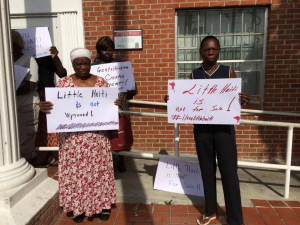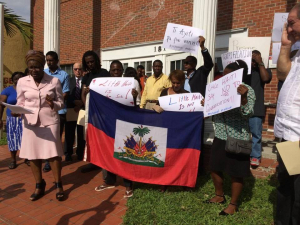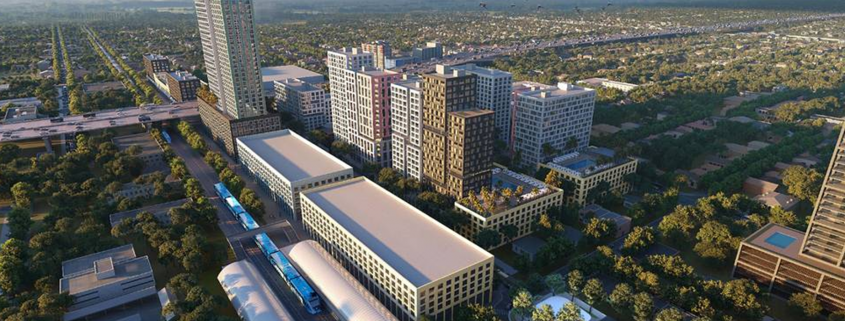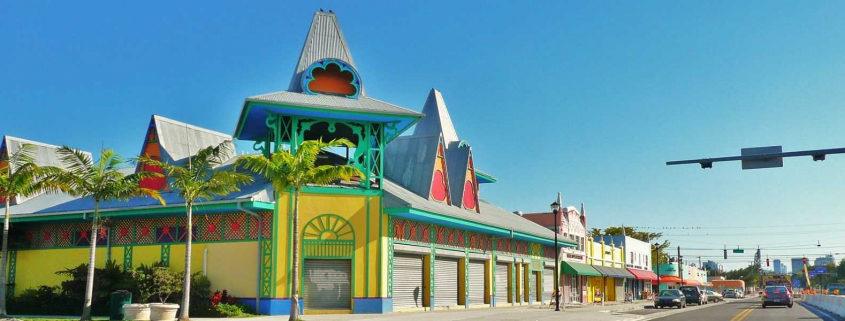Unlike much of the redevelopment now enveloping Miami, the plan spearheaded by Coconut Grove-based developer Swerdlow Group is aimed squarely at low-income and middle-class Miamians who are now finding it increasingly unaffordable to live in the city, especially in the urban core.
Posts
Whereas some scientific fashions predict sufficient polar ice soften to convey no less than 10 ft of sea stage rise to South Florida by 2100, only a modest 12 inches would make 15% of Miami uninhabitable, and far of that beachside property is amongst America’s most beneficial.
Even now, as extra frequent “king tides” bubble up via Florida’s porous limestone, pushing fish via sewers and onto streets, residents are changing into extra conscious that their metropolis is constructed on the rippling cabinets, ridges and canyons of a fossil seabed.
“Water is just going again to the identical locations it flowed ages in the past,” says Sam Purkis, Chair of the College of Miami’s Geosciences Division. “The irony is what occurred 125,000 years in the past goes to dictate what occurs to your own home now.”
The fickle undulations between metropolis blocks might imply the distinction between survival and retreat, and the rising price of altitude is sparking a noticeable shift in neighborhood activism and municipal budgets.
Miami Seaside is spending hundreds of thousands elevating roads, upgrading pumps and altering constructing codes to permit residents to lift their mansions by 5 ft. However in working-class, immigrant neighborhoods like Little Haiti, year-to-year sea stage rise will get misplaced within the day-to-day wrestle, and most had no concept that they dwell a lofty three ft increased than the rich of us on Miami Seaside.
They came upon when builders began calling, from all over the place.
“They have been calling from China, from Venezuela. Coming right here with circumstances of cash!” says Marleine Bastien, a neighborhood organizer and longtime resident. “We used to assume that the attract of Little Haiti was the truth that it is near downtown, near each airports and near the seashore. Unbeknownst to us, it is as a result of we are positioned at the next altitude.”
Mentioning a row of vacant outlets, she ticks off the names of a dozen small enterprise homeowners she says have been compelled out by rising rents, and lists others who she says unwittingly took lowball presents with no understanding of Miami’s housing disaster.
“In case you promote your private home in Little Haiti, you assume that you simply’re making a giant deal, and it is solely after you promote, and then you definately understand, ‘Oh, I can’t purchase anyplace else.’”
After her neighborhood middle and day faculty have been priced out of three totally different buildings, she caught wind of plans to construct the sprawling $1 billion Magic Metropolis growth on the sting of Little Haiti, that includes a promenade, high-end retail shops, high rise residences and imagined by a consortium of native buyers, together with the founding father of Cirque du Soleil.
Magic Metropolis builders insist that they picked the location based mostly on location, not elevation. They promised to protect the soul of Little Haiti and provides $31 million to the neighborhood for inexpensive housing and different applications, but it surely wasn’t sufficient for Bastien.
“This can be a plan to really erase Little Haiti,” Bastien says. “As a result of that is the one place the place immigration and local weather gentrification collide.”
She fought the event with all of the protesters and hand-lettered indicators she might muster, however after a debate that went till 1 a.m., commissioners authorised the allow with a Three-Zero vote on the finish of June.
“The world we took was all industrial,” says Max Sklar, VP with Plaza Fairness Companions and a member of the event staff. “There was no actual thriving financial system round these warehouses or vacant land. And so our objective is to create that financial system. Can we appease all people? Not 100%, that is not possible. It is not sensible. However we have listened to them.”
He repeats a promise to ship $6 million to a Little Haiti neighborhood belief earlier than ground is even damaged and, as an indication that he listened to no less than one demand, acknowledges that the advanced will now be known as Magic Metropolis Little Haiti.
However whereas Bastien mourns the defeat, her neighbor and fellow organizer Leonie Hermantin welcomes the funding and hopes for the perfect.
“Even when Magic Metropolis didn’t come immediately, the tempo of gentrification is so speedy that our folks won’t be able to afford houses right here anyhow,” Bastien says with a resigned head shake. “Magic Metropolis is just not the federal government. Reasonably priced housing insurance policies have to return from the federal government.”
“Local weather gentrification is one thing that we are very intently monitoring,” Miami Mayor Francis Suarez tells me. “However we have not seen any direct proof of it but.”
Suarez is the uncommon Republican who passionately argues for local weather mitigation plans and helped champion the $400 million Miami Perpetually bond, authorised by voters to fund motion to guard the town from the ravages of upper seas and stronger storms.
“We really created in our first tranche of Miami Perpetually, a sustainability fund for folks to renovate their houses in order that they’ll keep of their properties somewhat than having to promote their properties,” Suarez says.
However that fund is a comparatively small $15 million, not sufficient to dent a housing disaster that grows with every warmth wave and hurricane, in a metropolis the place over 1 / 4 of residents dwell under the poverty stage.
Philip Alston, the UN Particular Rapporteur on excessive poverty and human rights, mentioned there was already proof of how the local weather disaster impacts the wealthy and poor in a different way. And he identified that these harm most have been seemingly these least accountable.
“Perversely, whereas folks in poverty are accountable for only a fraction of world emissions, they’ll bear the brunt of local weather change, and have the least capability to guard themselves,” Alston wrote final month.
Source: Nosy Media
Homes at higher elevations in Miami are gaining value at a faster clip than those closer to sea level.
It’s an accelerating trend, and it has residents and real estate agents — in Miami and other coastal communities — asking whether “climate gentrification” has arrived. The term, which only recently entered the lexicon, describes the role of climate change in recalibrating land values, a phenomenon that ultimately could displace low-income and minority residents in a similar fashion as urban gentrification. As sea levels rise and flooding persists, the thinking goes in the case of Miami, waterfront property will lose some of its luster and higher-situated neighborhoods like Little Haiti and Little Havana will become more attractive.
The professor who was first to publish research using the phrase “climate gentrification” isn’t convinced that’s the main culprit in Miami. At least not yet. Jesse M. Keenan, a researcher on urban development and climate adaptation at Harvard’s Graduate School of Design, tracked the rate of price appreciation since 1971 for more than 250,000 residential properties in Miami-Dade County, and compared those figures to elevation. Keenan found that properties at high elevations have long appreciated faster in Miami, mostly because of nonclimate factors.
However, since 2000, the correlation between elevation and price appreciation has grown stronger, which Keenan, in an interview with CBS MoneyWatch, suggested may be “early signaling” of preference for properties at higher elevations and a reaction to persistent nuisance flooding in lower areas.
His prediction: Over the next 10 years, climate change will become a more significant factor in the real estate market for many cities. He expects a “slow burn” toward a tipping point — similar to the foreclosure crisis — when all of a sudden values drop precipitously for high-risk properties.
“This is real,” Keenan said. “There are actual people spending lots of money thinking about how to make money from climate change. We have to come to terms with this sooner than later.”
Keenan tracks at least three “pathways” to climate gentrification, and the variations stem in part from the “location, location, location” mantra of real estate. The three scenarios:
- Low-risk properties surge in value, fueling a migration from high-exposure areas, causing displacement. This isn’t just a sea-level issue: California’s wildfires, for instance, are likely to lead to significant changes in how real estate is valued. “Anything related to climate change,” Keenan explained. “Low exposure is the determinate.”
- Living in high-exposure areas gets so expensive (think taxes, insurance, etc) that only rich people can live there, pushing historically mixed-income areas (such as Miami Beach, Florida, and Hampton Roads, Virginia) to become more exclusive.
- Government investments in resilience have the unintended consequence of boosting land and property values that wind up displacing populations. Sea-level fortifications on the Lower East Side of Manhattan could have this affect, Keenan said.
What’s at stake?
“People’s lives, their livelihoods and their culture,” said Mustafa Santiago Ali, senior vice president of climate, environmental justice and community revitalization for the Hip Hop Caucus, a nonprofit that connects the Hip Hop community to civic life.
Ali, who previously spent 24 years in various roles at the Environmental Protection Agency, said it’s fairly easy to predict who the winners will be as climate gentrification takes hold — led both by one-time events such as hurricanes and the more gradual process of sea-level rise. The answer, of course, is wealthier people.
“Who has the resources? Who has the access?” Ali asked in an interview with MoneyWatch. “Who has the education to understand what’s coming and navigate that?”
One key to ensuring a more equitable outcome is making sure communities are heard, are involved in development, including “adaptation” measures to accommodate climate change, and have avenues to take advantage of rising property values, Ali said. In fact, climate will be a focus area of a new initiative of the Hip Hop Caucus set for launch in spring that targets vulnerable communities.
In Miami, residents of some inland coastal neighborhoods that sit at comparatively high elevations, including Little Haiti, worry that rising property values fueled by sea-level increases could price them out, as PRI reported last week.
Developers have proposed three new projects in the Little Haiti neighborhood that could push immigrants and people of color out, activist Valencia Gunder told PRI.
“In Miami, historically because of racism, redlining and segregation, all of the brown and black people were forced to live in the center of the city, which also happens to be the high elevated areas,” she told PRI. “So, they pushed us here because they didn’t want us on the beach.”
For some buyers these days, the beach looks like a better place to visit than to live. And it’s not just coastal areas that could face consequences of “climate gentrification.” Coastal residents are likely to flock to inland cities in droves — with Austin, Texas; Orlando, Florida; and Atlanta likely to gain the most new residents, according to a study by Mathew Hauer published by the journal Nature in April.
The study, which considers a sea-level rise of about six feet by the year 2100, forecasts a migration of as many as 13 million people (double the total of the Great Migration), with more than 2.5 million fleeing the region that includes Miami, Fort Lauderdale and West Palm Beach. New Orleans would lose about 500,000 people, the study predicts, and the New York City area would lose 50,000 people.
That doesn’t mean coastal areas would empty out. History shows people will always want to live near the water, noted Joel Myers, founder and president of commercial weather service AccuWeather Inc.
Sea levels have been rising for thousands of years, he added, and even as that rise accelerates, the other side of the coin is there’s less waterfront land available to purchase. A simple formula of supply and demand.
Click here to view the CBS MoneyWatch video ‘Climate Gentrification Could Add Value To Elevation In Real Estate’
Source: CBS News
Longtime residents, business owners and civic leaders gathered in Miami’s Little Haiti neighborhood on Thursday to deliver a message about their rapidly changing community: “We want to stay.”

Little Haiti residents say investors and real estate developers are buying property and pushing out the people and small businesses that give the district is distinct Caribbean flavor. (Photo Credit: Daniel Chang, The Miami Herald)
Residents and activists, many carrying hand-written signs declaring “Little Haiti is not for sale” and “Say no to gentrification,” said real estate developers and speculators are buying up land and pushing out the people and small businesses that give the neighborhood its distinct Caribbean character.
“They tried to push me out of this area,” said Wilfrid Joseph Daleus, a Haitian immigrant and owner of the Daleus Museum and Art Gallery on 59th Street and Northeast Second Avenue.
Daleus, 66, said he opened his art gallery in 1980 and loves the neighborhood. But his rent is rising, and he feels that local government could do more to help, such designating the area a historic or cultural district.
“The price goes up every month,” Daleus said, “and I don’t have the support to stay. … But I don’t want to go. I want to stay.”
The Little Haiti neighborhood of Miami — an area broadly defined as running from 38th Street to 79th Street between Interstate 95 and the Florida East Coast Railway — does not have an official boundary, though city commissioners have considered a formal designation in the past.
Little Haiti gained its name as Haitian migrants, fleeing the regime of Jean Claude “Baby Doc” Duvalier, began to populate the neighborhood in the late 1970s and early 1980s.

Longtime residents, business owners and civic activists gathered to protest what they see as the gentrification of Little Haiti. They produced a list of demands, including the creation of a cultural district and the establishment of a trust to preserve and acquire land in the district for housing and businesses (Photo Credit: Daniel Chang, The Miami Herald)
Lately, though, art galleries have moved north from Wynwood in search of more affordable rents in Little Haiti. And developers have taken increasing interest in the area, using harassment, intimidation and sometimes inducements to coerce longtime residents and businesses to move, said Marleine Bastien, executive director of Haitian Women of Miami, a community group.
Bastien told a group gathered in front of the offices of the Haitian American Community Development Corporation on Northeast 82nd Street that “a lot of investors and developers are “organizing to change the name of Little Haiti. They are buying left and right, cash. The Little Farm Mobile Court on Biscayne Boulevard, home to many Haitian immigrants, has been purchased through lawyers by a Chinese investor who doesn’t even live here.”
Joined by representatives from local civic groups and elected officials, including Michael Etienne, city clerk for North Miami, Bastien presented a list of demands for Miami leaders, including the creation of a historic or cultural district and the establishment of a community land trust to preserve existing land and acquire new property for housing and small businesses.
She called for fast action from Keon Hardemon, a Miami commissioner whose district includes the Little Haiti neighborhood. “If he doesn’t act,” she said, “soon Little Haiti will disappear.” Hardemon did not respond to an interview request from the Herald made through his chief of staff on Thursday.
Miami Mayor Tomás Regalado said the city has never designated any area in honor of any immigrant group, including Little Havana. But, he said, that doesn’t mean Miami has overlooked the contributions of immigrant groups that have contributed to the city’s history.
“The Haitian heritage can never be erased from the history of Miami,” Regalado said. “It’s still there in Little Haiti, although some Haitians have moved, but still we have the Little Haiti Soccer Park. We have the Little Haiti Cultural Center. We have the Caribbean Marketpalce.”
Source: Miami Herald
About Us
Ven-American Real Estate, Inc. established in 1991, is a full service commercial and residential real estate firm offering brokerage and property management services.
Subscribe
Contact Us
Ven-American Real Estate, Inc.
2401 SW 145th Avenue, Ste 407
Miramar, FL 33027
Brokerage & Property Management Services
Phone: 305-858-1188




